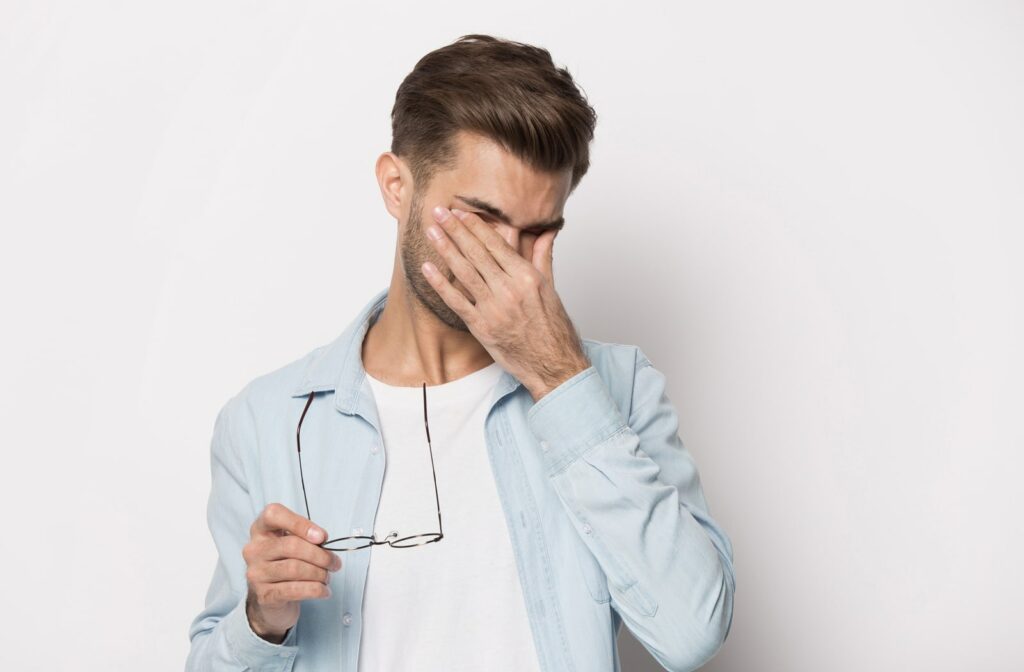Have you ever noticed squiggly spots in your line of vision when looking at a clear sky, white paper, or the inside of your eyelid? These are called floaters.
Floaters are common, generally harmless, and don’t need treatment. If you experience floaters, your optometrist can diagnose them during a routine eye exam.
So what causes floaters? They occur from the natural aging process and not from dry eyes. Dry eyes or dry eye disease is also a result of the natural aging process but more so because of the imbalance in the tear film.
Let’s look at dry eyes and floaters in more detail to see how they aren’t connected.
Dry Eye Disease
Dry eye disease is a condition where the eye lacks lubrication either from lack of tear production or poor quality tears. Tear glands produce tears that have water, oil, and mucous. When there’s an imbalance in the tear film mixture, the tears evaporate too quickly or don’t coat the eyes properly.
Patients with dry eye syndrome often complain of the following symptoms:
- Irritation and itchy eyes
- Eye fatigue and pain
- Redness
- Discomfort when wearing contact lenses
- Burning sensation
- A foreign body sensation in the eye
- Tearing up or watery eyes
- Sensitivity to smoke and wind
Causes of Dry Eyes
We’ve established that dry eyes are due to a disruption in the healthy tear film. There are several causes for this:
Age: Age is a risk factor for dry eyes as tear production declines with age. It affects people over 50.
Hormone changes: The most common cause of dry eyes in women is menopause, pregnancy, and the use of birth control pills. An imbalance in hormones can reduce tear production.
Direct exposure: To the sun, cold, wind, smoke, and low humidity can also result in dry eyes.
Autoimmune disease: Conditions such as Sjogren’s syndrome, arthritis, lupus, and diabetes can cause insufficient or poor quality tears.
Inflammation: Known as blepharitis, the oil glands in the inner eyelid become clogged and inflamed.
Medications: Antihistamines, antidepressants, and beta-blockers can reduce mucous production.
Computer use: Long hours in front of the computer leads to less blinking and more evaporation of tears.
Treatment of Dry Eyes
Every person experiences dry eyes differently, and thus treatment methods will vary. Options include:
- Sunglasses to protect the eyes from outside elements
- Eye drops that help create high-quality tears
- Regular breaks when using the computer
- In-office treatment to remove biofilm buildup around the eyes
Floaters
Floaters appear in the middle of your vision and come in different shapes similar to cobwebs, dark spots, streaks or lines, squiggles, and rings. They don’t move, but when you try to focus on them, they dart away.
The number of floaters increases with age, but they typically don’t cause any problems. If, however, you notice these changes visit your optometrist immediately, as they could be a sign of something else:
- The sudden increase in floaters
- Flashes of light
- A loss of side or peripheral vision
- Floaters after eye surgery or eye trauma
- Eye pain
You are at increased risk of floaters if you are over age 50, are nearsighted, have diabetes, have eye inflammation, and had cataract surgery.
Causes of Floaters
The most common cause for floaters is age. As you age, the eye’s vitreous humour (gel-like fluid in the eye) shrinks and protein fibres in the fluid clump together. When these create shadows on the retina, they appear as floaters.
Other causes of floaters include:
- Inflammation in the eye: Also called uveitis, symptoms include pain, redness, and sometimes vision loss.
- Blood in the eye: In the case of diabetic retinopathy
- Vitreous detachment: This occurs when the vitreous pulls away from the retina.
- Retinal tear: A retinal tear is when vitreous detachment causes a tear or hole in the retina.
- Retinal detachment: When the retina pulls away from the back of the eye.
- Eye injuries
- Eye infections
Treatment for Floaters
Because they stem from the normal aging process, floaters need no treatment. If there are many floaters, they affect your vision, or if caused by underlying conditions, treatment can include a vitrectomy.
Vitrectomy involves removing the vitreous liquid and replacing it with another solution. Another treatment option is using a laser to break up the floaters for better vision. It’s always best to speak to your eye doctor about which treatment method will work best for you.
Relief for Dry Eyes
You are now aware of 2 eye conditions, dry eyes and floaters, and that dry eyes do not cause floaters. No one should suffer eye pain, irritation, and floaters if it affects their vision.
Book an appointment with Total Focus Family Optometry Centre today if you notice dry eyes or floater symptoms. We can help solve the root of your vision problems with proper diagnosis and dry eye therapy.



